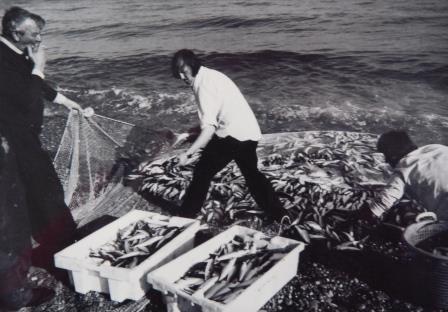The ‘Queen of Crime’ and Budleigh
Agatha Christie (far left): a regular visitor to Budleigh
There’s a dash of Agatha Christie about the place,
was journalist Tom Dyckhoff’s verdict on Budleigh Salterton in a review of the
town published in the Guardian some ten years ago. ‘You feel, at any moment, as
if Hercule himself might pop out of The Feathers following a gin fizz.’
Perhaps that was why Budleigh was chosen as a
location for the filming of crime mysteries like ‘Nemesis’ and ‘Sleeping
Murder’ in the BBC's ‘Miss Marple’ series.
But did you know and
did the TV people know that the so-called ‘Queen of Crime’ was a regular
visitor to the town?
The above photo was kindly sent to me by a member of the Budleigh - Past and Present Facebook group. It shows
her in the garden of ‘High Knowle’ on Dark Lane, Little Knowle, on the
outskirts of Budleigh Salterton, with, on her left, her friends John Reeder
Makeig-Jones CBE and his wife Agnes. My source was not
able to identify the other couple.
A photo of Agatha Christie promoting her 1977 book An Autobiography Image credit: Wikipedia
Mrs Makeig-Jones,
born in Torquay in 1892 as Agnes Antonia Yvonette Dundee-Hooper was two years
older than Agatha Christie but the pair were best friends, as they grew up
together in the town, both living in large Victorian villas.
Image credit: https://openplaques.org
Agnes’ home was 'Ardvar', on Higher Warberry Road. Agatha lived at 'Ashfield' on Barton Road, sadly demolished in 1962. Well I suppose this blue plaque, produced by the Torquay Civic Society, is better than nothing. But, as an ex-French teacher, I'm sorry to have to note that the acute accent is in the wrong place on that plaque.
Image credit: https://openplaques.org
Agnes’ home was 'Ardvar', on Higher Warberry Road. Agatha lived at 'Ashfield' on Barton Road, sadly demolished in 1962. Well I suppose this blue plaque, produced by the Torquay Civic Society, is better than nothing. But, as an ex-French teacher, I'm sorry to have to note that the acute accent is in the wrong place on that plaque.
Agatha was Agnes’ bridesmaid at the latter’s wedding and they remained close until Agatha passed away in 1976. John Reeder Makeig-Jones spent his career in the Indian Civil Service, for which he was appointed CBE, and seems to have lived in Ottery St Mary at some stage.

'High Knowle', described by a local estate agent as 'one of Budleigh's finest family homes, believed to date from 1923 and to have been built for a member of the Huntley & Palmer family'. And visited by Agatha Christie!
Following the couple’s return to Britain and their move to Budleigh, Agatha Christie visited ‘High Knowle’ on a quite regular basis, as mentioned in the estate agents’ brochure for the house sale like the one above.
No Case for the
Police was published in 1970, the year of
the author’s death. He is buried in East Budleigh churchyard
Actually, well before
any filming of Agatha Christie’s books took place in Budleigh, crime writer
V.C. Clinton–Baddeley chose the town in which he’d grown up for the setting of
his detective novel No Case for the
Police.
Or rather, he thinly disguised it, calling this 'old-word resort' Tidwell St Peter’s. He bases his plot around a drug-smuggler who looks like 'the original sailor in Ambrose Faddle's masterpiece' - surely a reference to Millais' painting 'The Boyhood of Raleigh'.
The Rolle Hotel before the building's transformation into flats. It was originally known as The Rolle Arms Hotel.
His Budleigh-born version of Hercule Poirot is called Dr Davie, and is a bit of a foodie; the detective, returning to the village where he grew up, is delighted to discover that the Ottery Arms – the author’s name for the Rolle Hotel – still knows how to make a decent mayonnaise.
But that’s another story!
‘Everyone lives to be
a hundred and two here,’ says one of the characters in the novel, ‘but most of
them can’t move after the age of ninety’.
Commercial mackerel fishing on Budleigh beach. Photo from the Nick Loman Collection, kindly lent for the 'Sea, Salt and Sponges' (2013) exhibition at Fairlynch Museum
I really enjoyed
spotting the clues that Clinton-Baddeley was in reality writing about Budleigh:
they range from his mention of that enormous and ancient rhododendron on West
Hill to an old Saltertonian’s reminiscences of the great days of mackerel
fishing.
The Rolle Hotel before the building's transformation into flats. It was originally known as The Rolle Arms Hotel.
His Budleigh-born version of Hercule Poirot is called Dr Davie, and is a bit of a foodie; the detective, returning to the village where he grew up, is delighted to discover that the Ottery Arms – the author’s name for the Rolle Hotel – still knows how to make a decent mayonnaise.
But that’s another story!
You can access other posts on this blog by going to the Blog Archive (under the ‘About Me’ section), and clicking on the appropriate heading.









Comments
Post a Comment